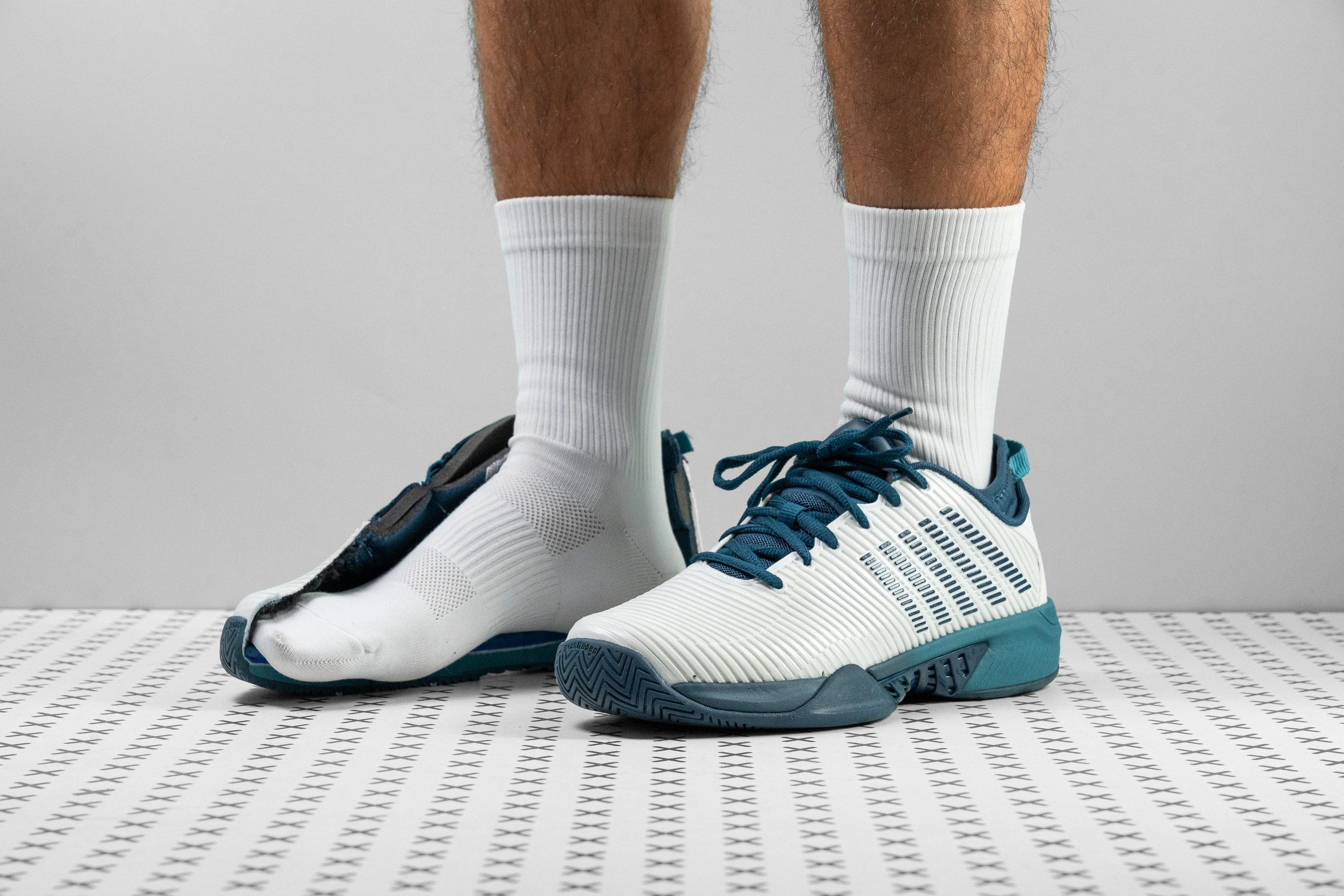Our verdict
- Top pick in best lightweight tennis shoes
Pros
- Nimble and lighter than average
- Grounded feel underfoot
- Outstanding durability
- Very wide platform
- Soft bootie molds to the ankle
- Excellent balance of grip and give
- Flexible yet propulsive
Cons
- Not very breathable
- Not for narrow feet (upper stretches)
- Not so supportive
Audience verdict
- Top 13% in all court tennis shoes
- Top 12% in lightweight tennis shoes
Comparison
The most similar tennis shoes compared
+ + Add a shoe | |||||
|---|---|---|---|---|---|
| Audience score | 91 Superb! | 93 Superb! | 88 Great! | 89 Great! | |
| Price | $130 | $150 | $120 | $120 | |
| Shoe type | All CourtHard Court | All CourtHard Court | All CourtHard Court | All CourtHard Court | |
| Shock absorption | - | Moderate | Low | Moderate | |
| Energy return | - | Moderate | Moderate | Moderate | |
| Traction | - | Moderate | Low | Moderate | |
| Construction | Speed | Speed | Speed | Stability | |
| Breathability | Moderate | Breathable | Breathable | Moderate | |
| Weight lab | 12.3 oz / 349g | 11 oz / 312g | 12.1 oz / 343g | 14 oz / 397g | |
| Lightweight | ✓ | ✓ | ✓ | ✗ | |
| Drop lab | 7.1 mm | 10.1 mm | 8.8 mm | 6.3 mm | |
| Width / fit | Medium | Narrow | Medium | Medium | |
| Toebox width | Medium | Medium | Medium | Narrow | |
| Size | Slightly small | Half size small | True to size | Slightly small | |
| Midsole softness | Firm | Balanced | Firm | Firm | |
| Stiffness | Stiff | Flexible | Moderate | Stiff | |
| Torsional rigidity | Flexible | Moderate | Flexible | Moderate | |
| Heel counter stiffness | Flexible | Stiff | Moderate | Moderate | |
| Midsole width - forefoot | Very wide | Wide | Average | Wide | |
| Midsole width - heel | Average | Average | Narrow | Wide | |
| Outsole durability | Decent | Bad | - | Good | |
| Heel padding durability | Decent | Bad | - | Decent | |
| Heel stack lab | 26.8 mm | 28.3 mm | 26.4 mm | 29.7 mm | |
| Forefoot | 19.7 mm | 18.2 mm | 17.6 mm | 23.4 mm | |
| Insole thickness | Average | Average | Average | Average | |
| Removable insole | ✓ | ✓ | ✓ | ✓ | |
| Heel tab | Finger loop | None | None | None | |
| Toebox durability | Good | Decent | - | Decent | |
| Outsole hardness | Average | Average | Average | Average | |
| Outsole thickness | Average | Average | Average | Thin | |
| Ranking | #4 Top 11% | #1 Top 3% | #10 Top 26% | #7 Top 18% | |
| Popularity | #28 Bottom 28% | #4 Top 11% | #24 Bottom 38% | #11 Top 29% |
Who should buy
Having thoroughly enjoyed the comfort and performance of the K-Swiss Hypercourt Supreme, we can readily recommend it to tennis players who:
- want plenty of comfort in a lighter-than-average shoe
- need a roomier fit for their foot shape
- would like a highly durable yet sleek tennis shoe
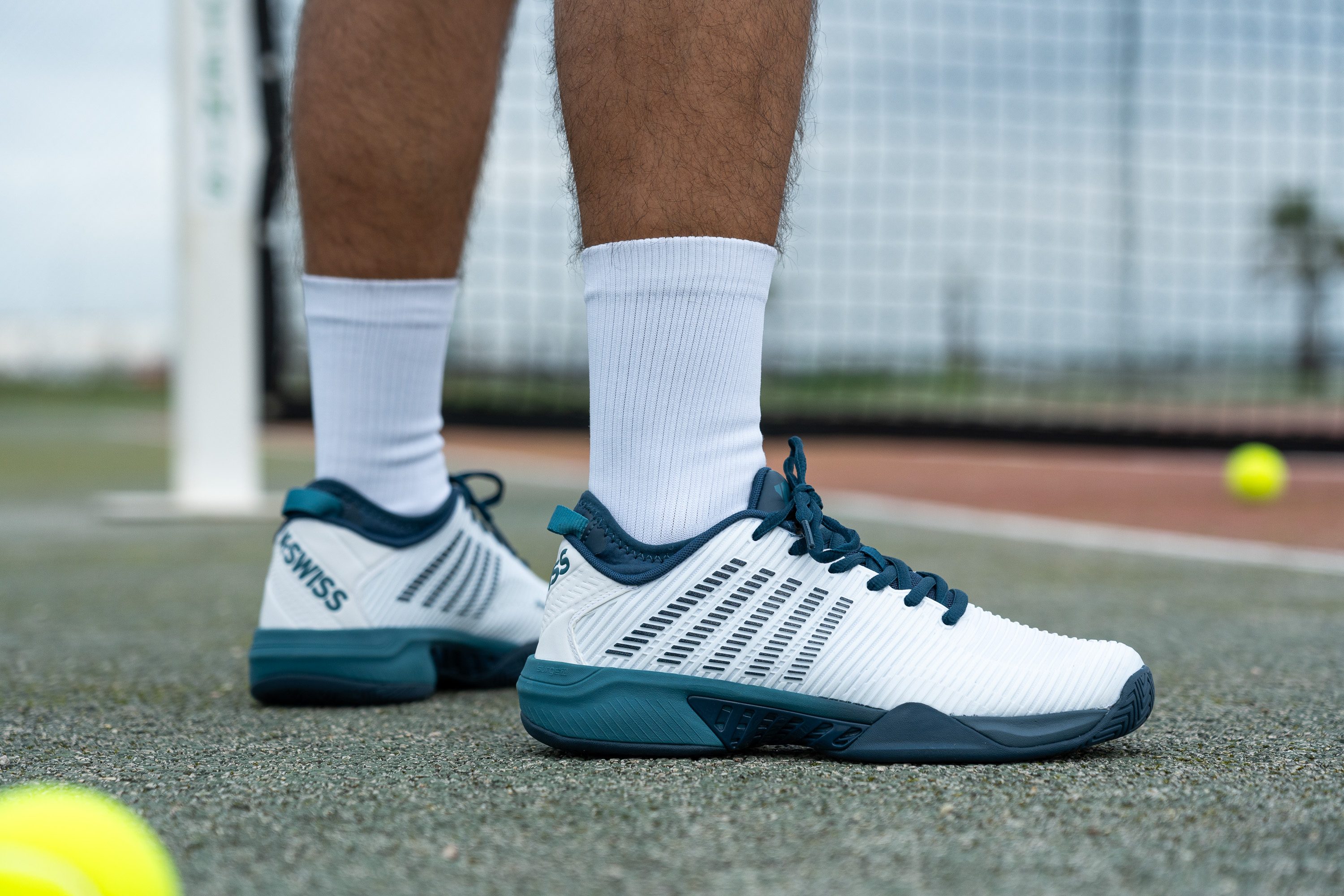
Who should NOT buy
Inner bootie aside, we found that The Hypercourt Supreme is a twin brother to the K-Swiss Hypercourt Express 2. So if you fancy saving $20 on tennis shoes and have no problem with a traditional heel cup design, the Express 2 is a more reasonable option.
Stretching of the upper is another reason to consider alternative options to this K-Swiss shoe. Especially if you have narrow feet. Some of the form-fitting shoes include the ASICS Solution Speed FF 2 and the Nike Vapor Pro.
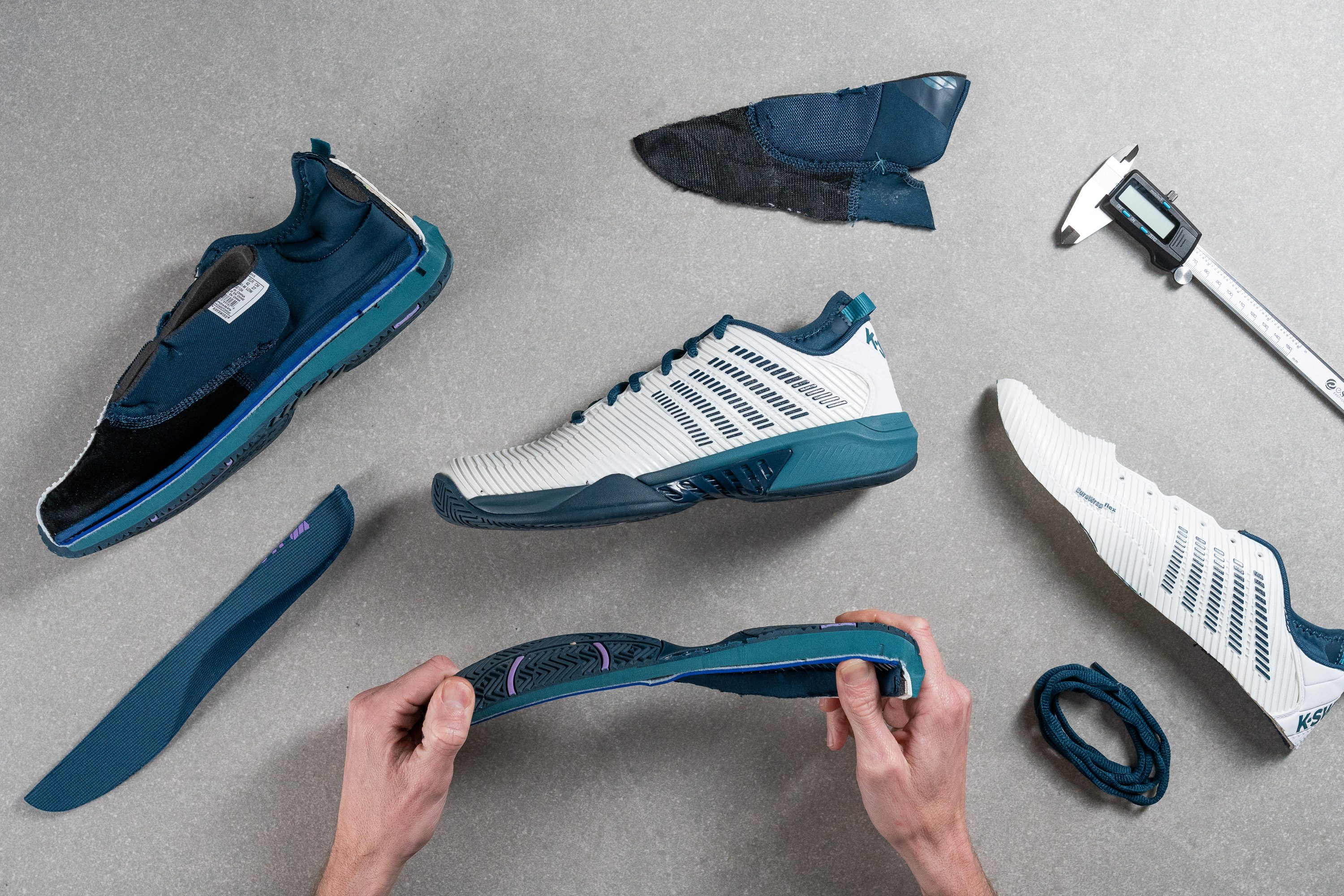
Cushioning
Heel stack
Assessing the overall construction of the Hypercourt Supreme, we believe that it belongs to the more speed-oriented bunch of tennis shoes. It features less cushioning than the average tennis shoe with a stack height of 26.8 mm in the heel.
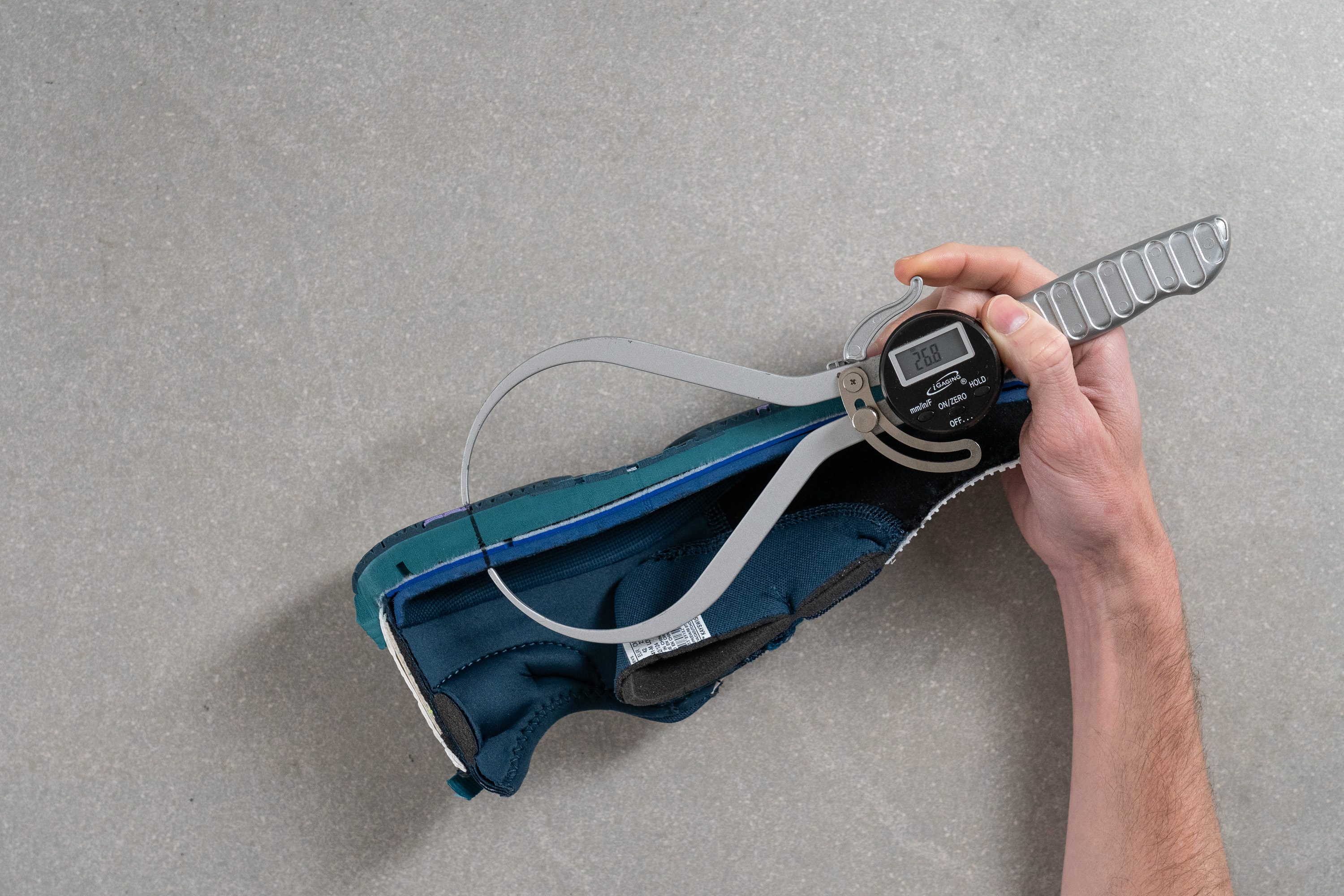
Based on our caliper measurements, this is lower than the shoe's close competition, the Adidas Ubersonic 4.1 (29.7 mm) and the ASICS Solution Speed FF 2 (31.2 mm).
This K-Swiss shoe may not be the best for hard landings but we felt like it was ideal for an agile and fluid playing style.
| Hypercourt Supreme | 26.8 mm |
| Average | 29.2 mm |
Forefoot stack
In the forefoot part of the midsole, our caliper measured 19.7 mm of stack height. It's not the lowest on our roaster but definitely feels grounded on the court.
We enjoyed the responsiveness and ease with which we changed directions of our feet.
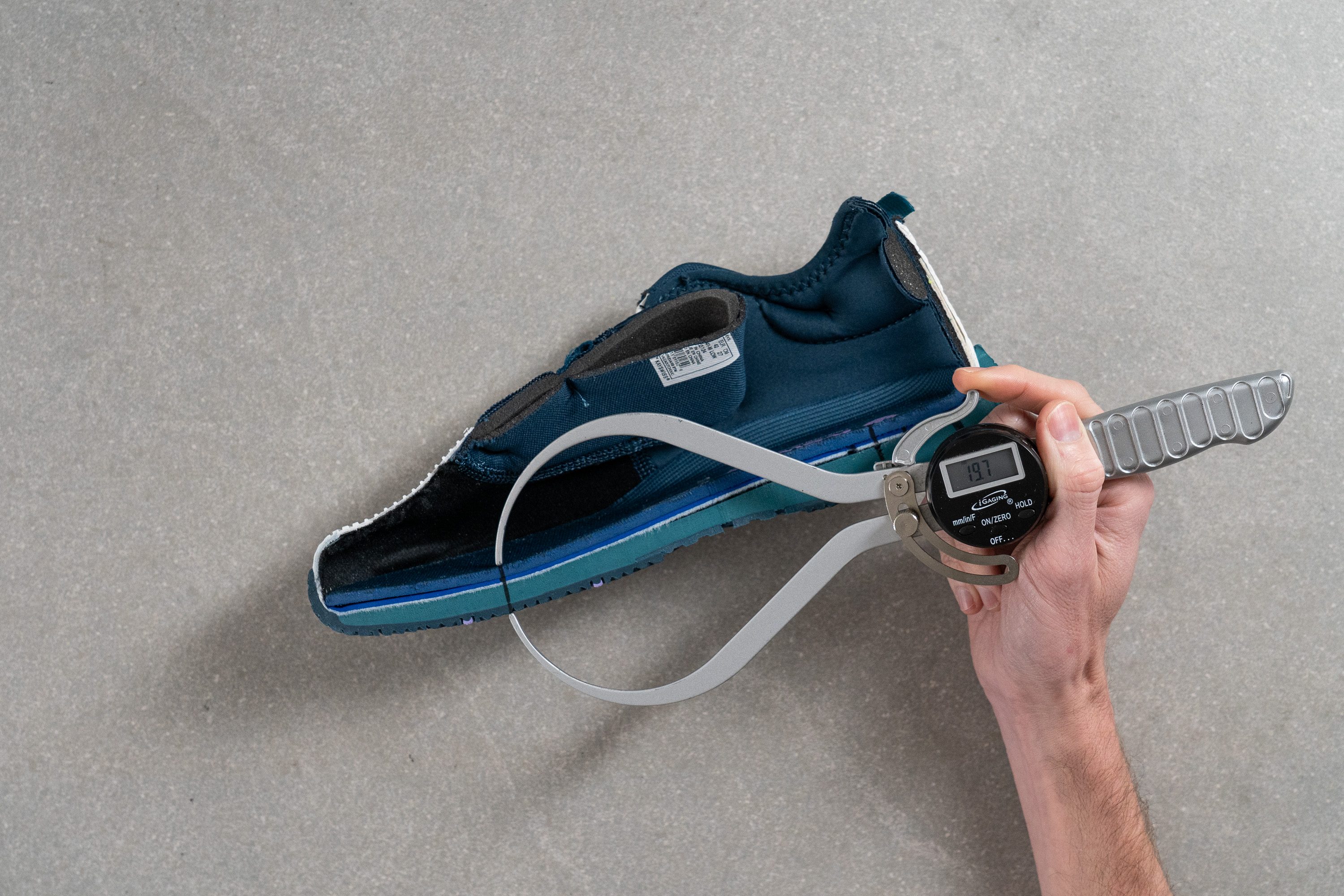
| Hypercourt Supreme | 19.7 mm |
| Average | 19.5 mm |
Drop
But the real secret to the shoe's very grounded feel is the small difference in height between its heel and forefoot. Looking at our caliper measurements, we got a drop of only 7.1 mm which is notably lower than the average of tennis shoes. It is actually among the lowest we've seen in this footwear category!
It works by placing your foot nearly parallel to the ground, minimizing the heel elevation. You feel less cushy but more connected and intimate with the ground. This is what makes a tennis shoe perfect for acceleration and moving all over the court.
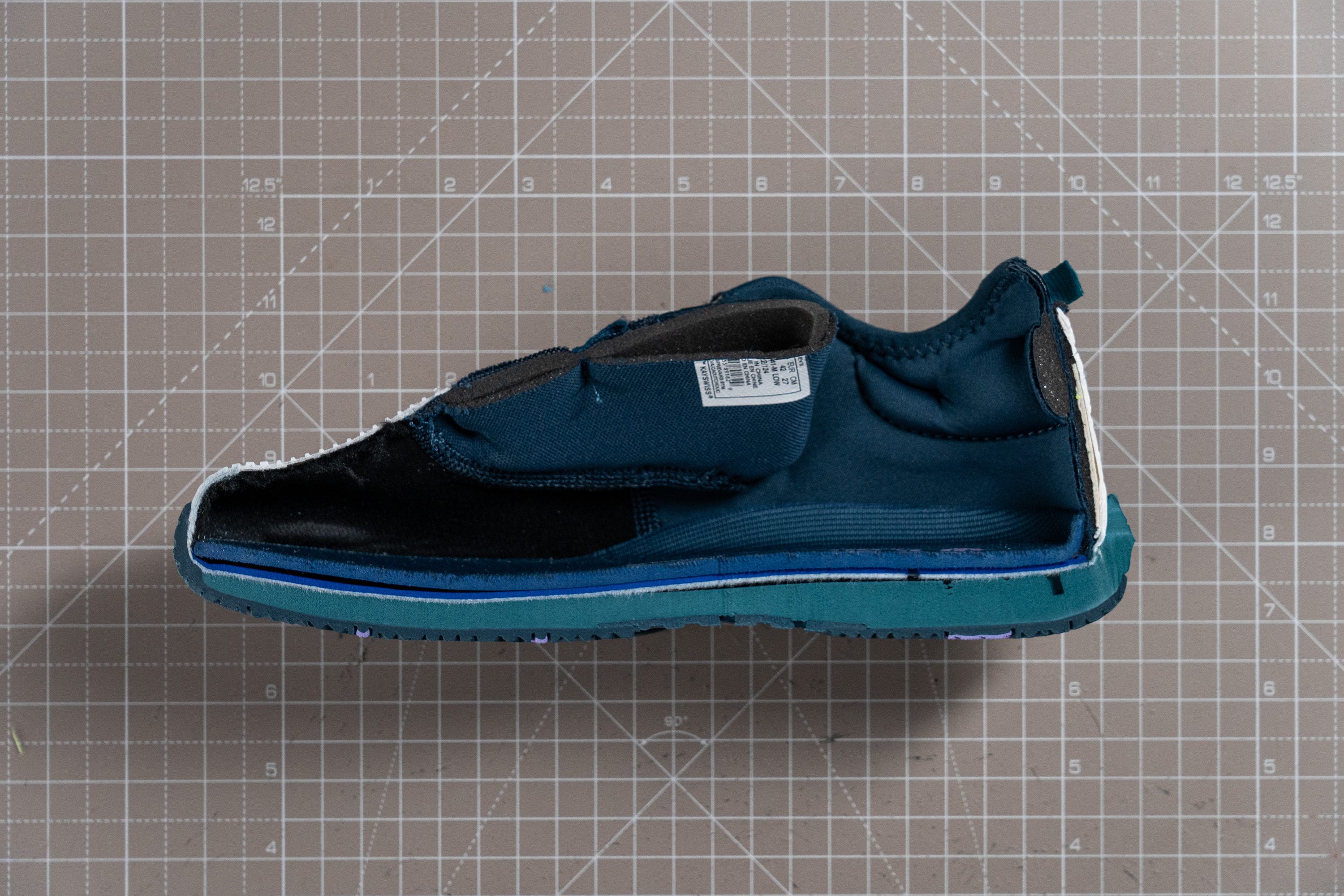
| Hypercourt Supreme | 7.1 mm |
| Average | 9.7 mm |
Midsole softness
Just like its Hypercourt sibling, the Express 2, the K-Swiss Supreme features a Surgelite foam as the main and only cushioning unit.
But with the help of a durometer, we found that the foam on the Supreme is notably firmer than on the Express 2. Pressing the tool against the same spot on both shoes, it returned 33.0 HA for the Supreme and 24.5 HA for the Express 2. That makes the Supreme 35% firmer!
It also turned out to be on the firm side of the spectrum across all tennis shoes.

| Hypercourt Supreme | 33.0 HA |
| Average | 28.1 HA |
Size and fit
Size
K-Swiss Hypercourt Supreme fits slightly small (11 votes).
Width / Fit
K-Swiss shoes just don't seem to need breaking in at all! It took minutes for us to feel fully comfortable in the Hypercourt Supreme.
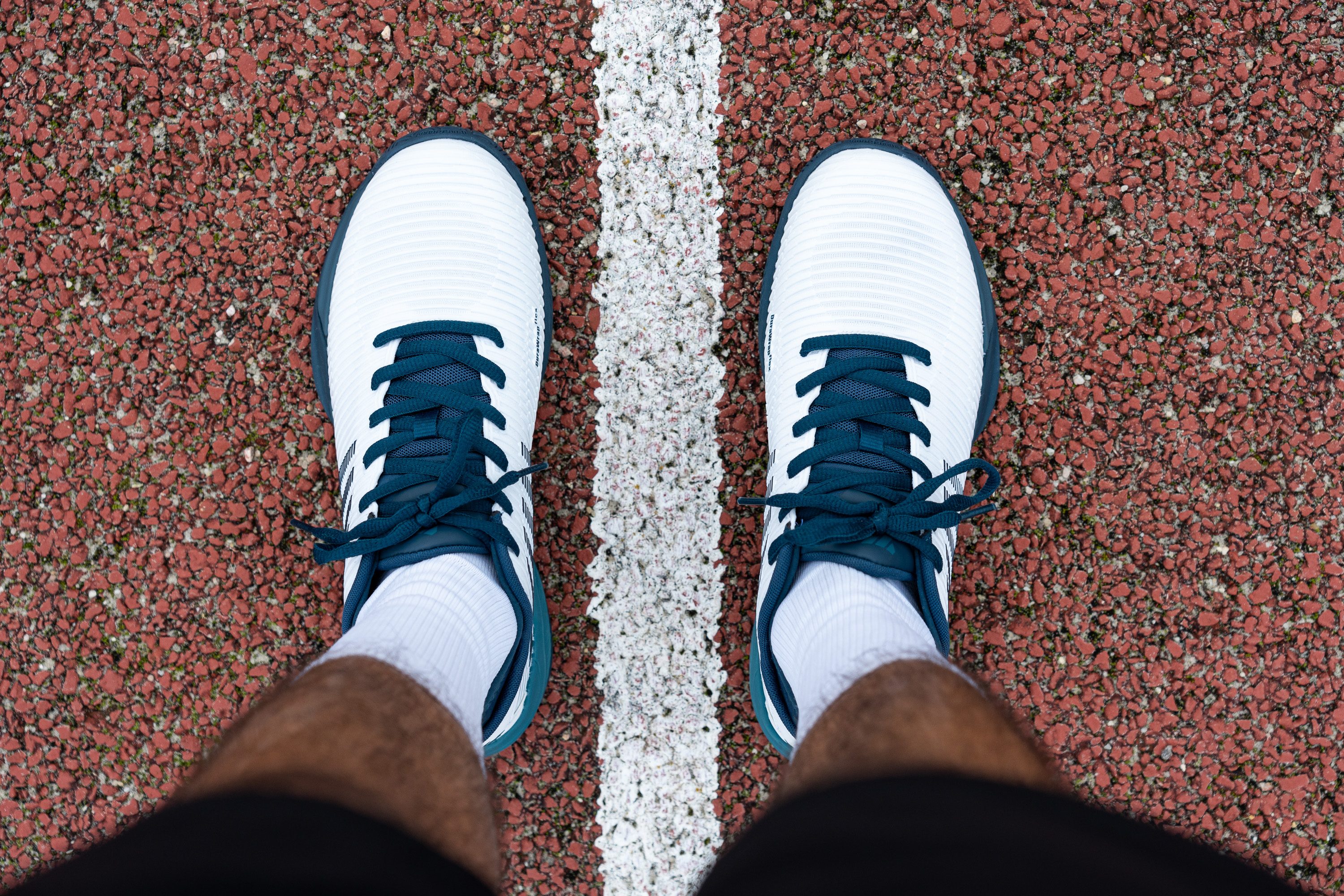
From the start, the shoe felt right at home to our medium-width feet. Our caliper confirmed an average width of 102.0 mm in the widest part of the toebox.
However, the shoe's upper tends to stretch out which can become a problem for narrow feet.

This test follows an older methodology, which is why you don't see recently tested shoes in the chart. Results from different methodologies can not be compared.
| Hypercourt Supreme | 102.0 mm |
| Average | 101.0 mm |
Toebox width
There is also no extreme tapering in the shoe's toebox. Measuring its width at the big toe mark, we got 75.4 mm.
Based on numbers only, the Hypercourt Supreme appears to be a proper medium-width shoe. However, because it is not as structured and heavily padded inside, it ends up stretching away from its original form.
Since the shoe has no extra eyelets for a runner's knot, there is not much that you can do other than go for a more form-fitting option. Say the ASICS Solution Speed FF 2 or the Nike Vapor Pro.
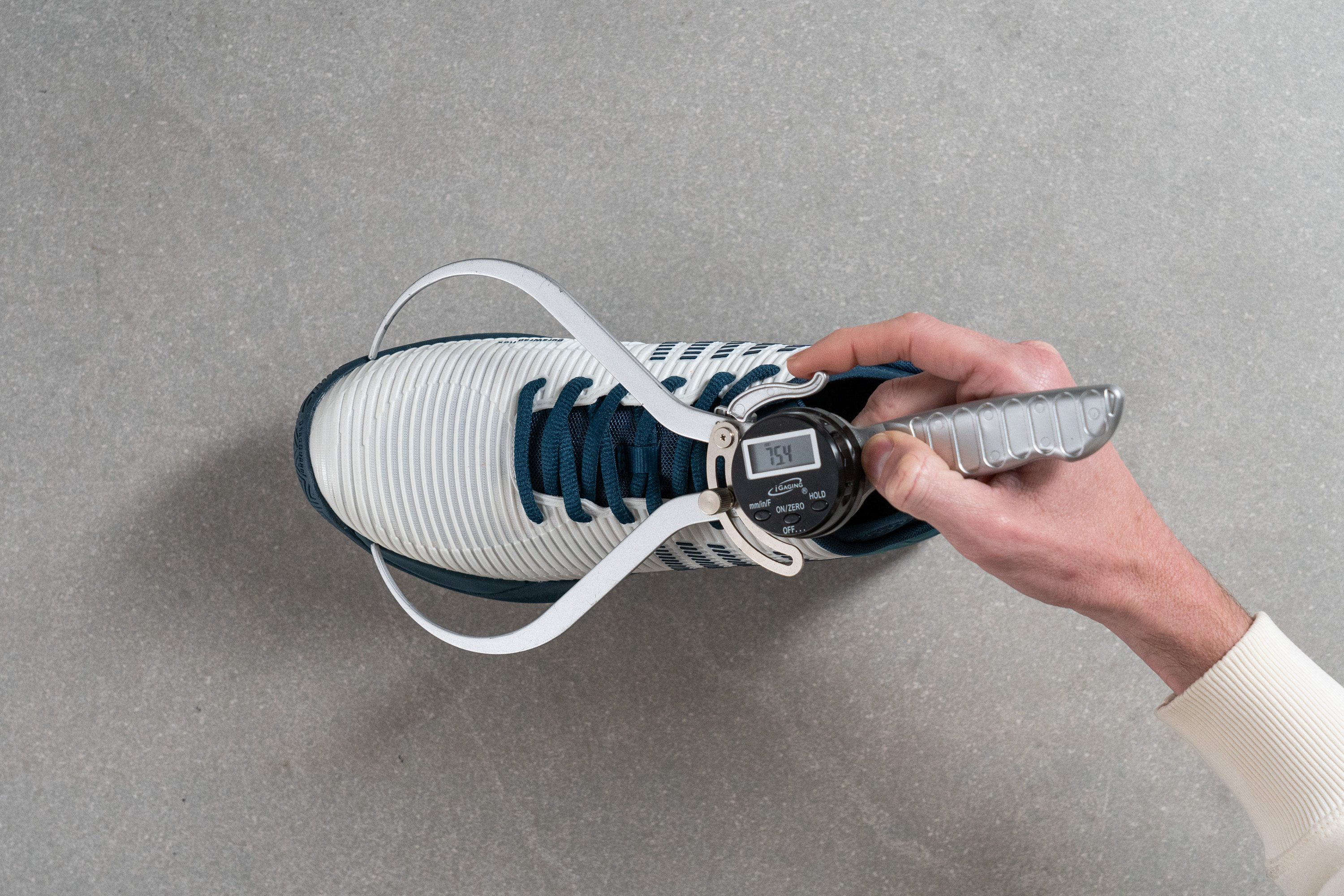
This test follows an older methodology, which is why you don't see recently tested shoes in the chart. Results from different methodologies can not be compared.
| Hypercourt Supreme | 75.4 mm |
| Average | 76.9 mm |
Behind the design
Even though the Hypercourt Supreme looks a lot like the Express 2 at first sight, the differences in their upper design are substantial. The Supreme was created in collaboration with Marcon Giron who used to play in the original Express shoe.
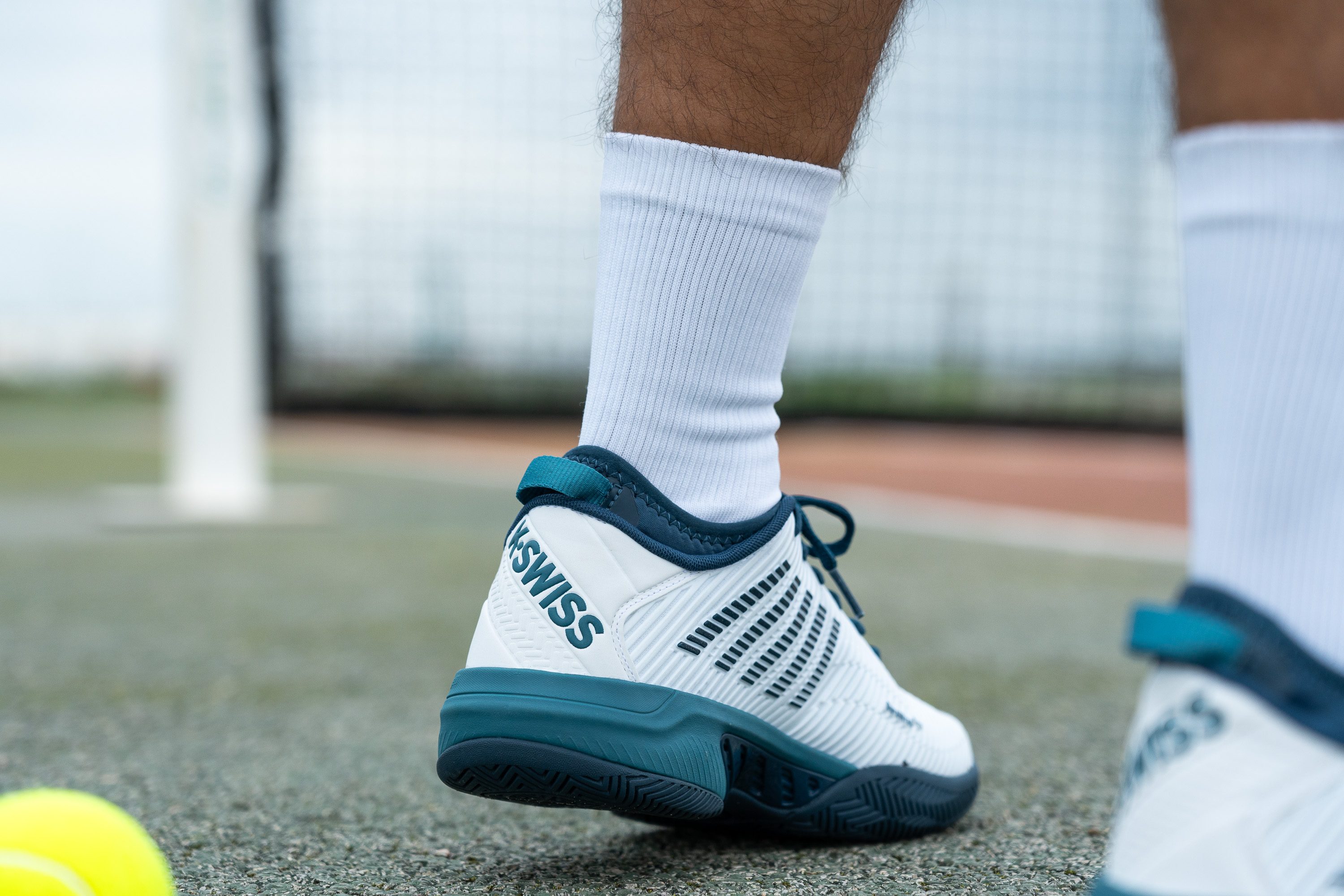
It was his goal to adapt a K-Swiss shoe to the demands of professional tennis play. This resulted in the shoe's bootie-like collar which has a softer inner layer to wrap around the ankle and a harder outer shell for structure.
Flexibility / Stiffness
The Hypercourt Supreme also treated us to a bit of a forward propulsion courtesy of the stiff shank.
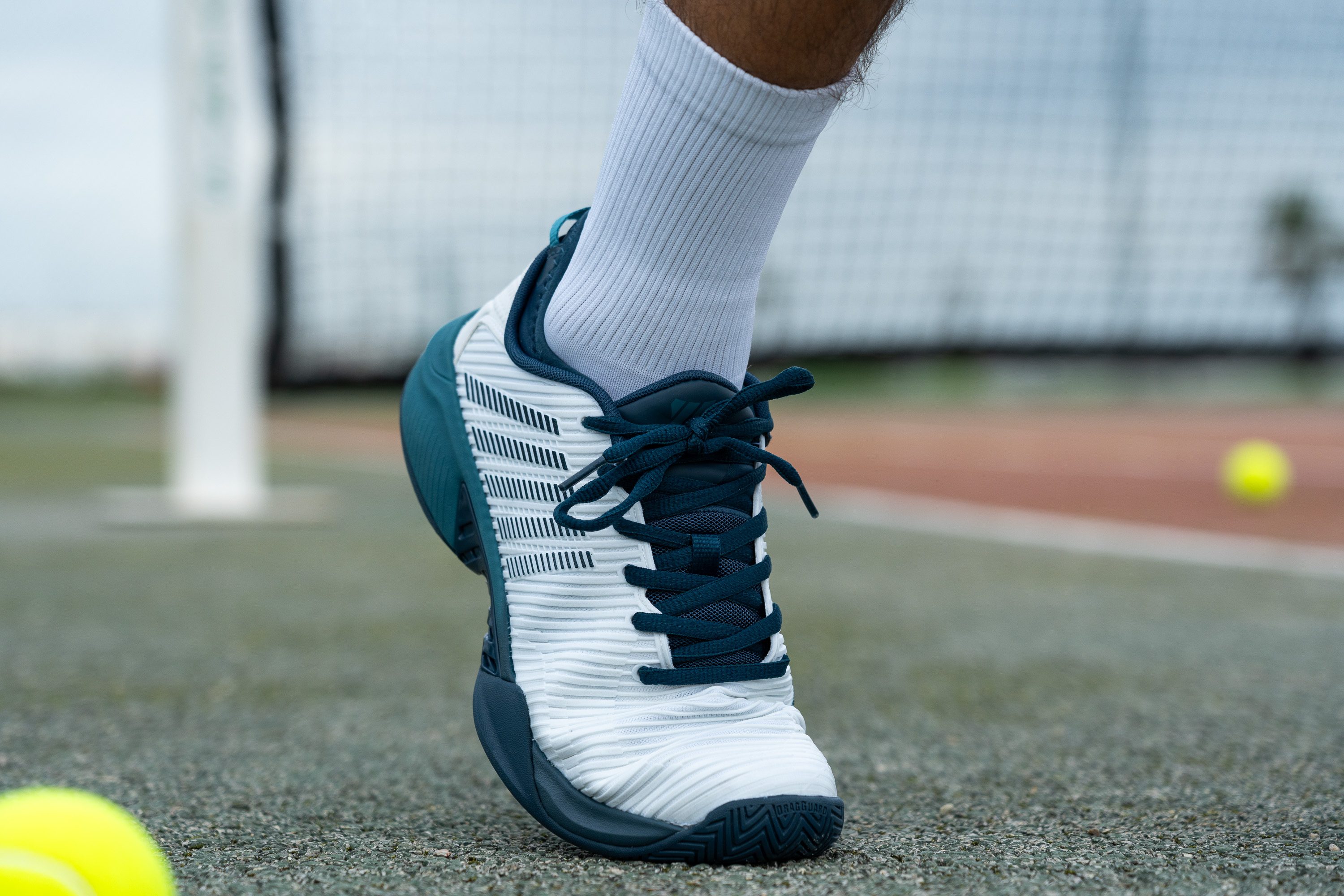
To compare it with other tennis shoes, we used a gauge to measure how much force it takes to bend the Supreme to a 90-degree angle. Turns out that at 32.6N, it is only 5% stiffer than the average tennis shoe. To us, that meant having a nice push-off while also being able to bend the foot and maneuver.
This test follows an older methodology, which is why you don't see recently tested shoes in the chart. Results from different methodologies can not be compared.
| Hypercourt Supreme | 32.6N |
| Average | 30.7N |
Weight
The Hypercourt Supreme weighs exactly the same as its counterpart, the Hypercourt Express 2. We weighed both shoes in a men's US size 9 and got 12.3 oz (349g).

Even though it is already considered lightweight for a tennis shoe, the Supreme feels even lighter on foot. That must be due to its sleek and streamlined silhouette. Never once did we feel hindered or bothered by the weight in this K-Swiss shoe.
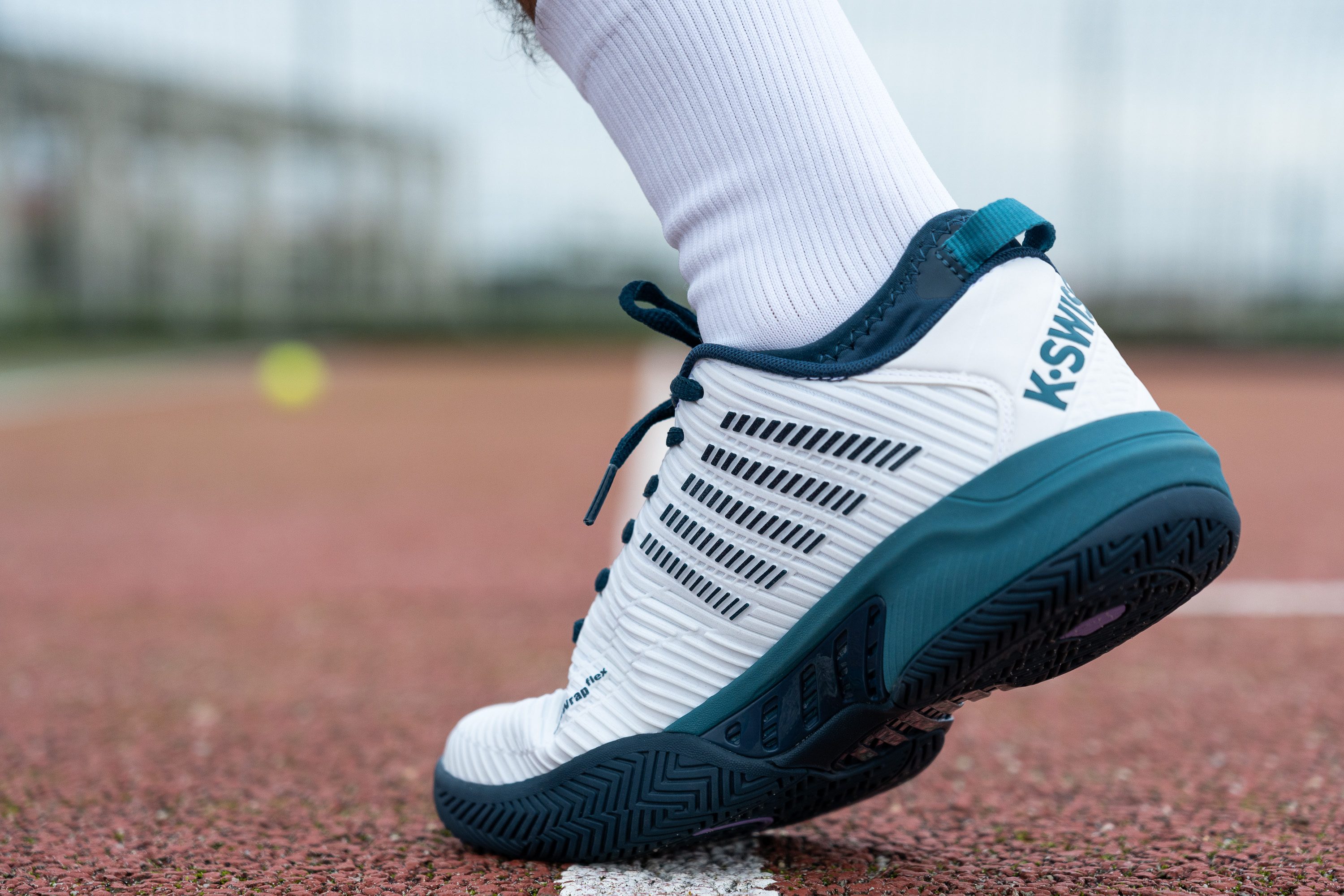
| Hypercourt Supreme | 12.3 oz (349g) |
| Average | 12.8 oz (362g) |
Breathability
During the playtest, our feet didn't get too toasty but neither did they feel refreshed. The upper of the Hypercourt Supreme felt a lot like many other tennis shoes with reinforced uppers.
Performing our in-house breathability test in the lab, we filled the upper of this K-Swiss shoe with smoke. As expected, most of it came out through the mesh tongue and only a tiny bit crippled through the toebox.
This convinced us to lower the shoe's breathability score to a moderate 3 out of 5. Which is a typical score for a tennis shoe.
Even when we tried to proactively look for ventilation holes by hovering the shoe's half-cut upper over the light, we couldn't see a single perforation light up in the test!
Looking at the shoe's toebox through a microscope helped us put all the puzzle pieces together.
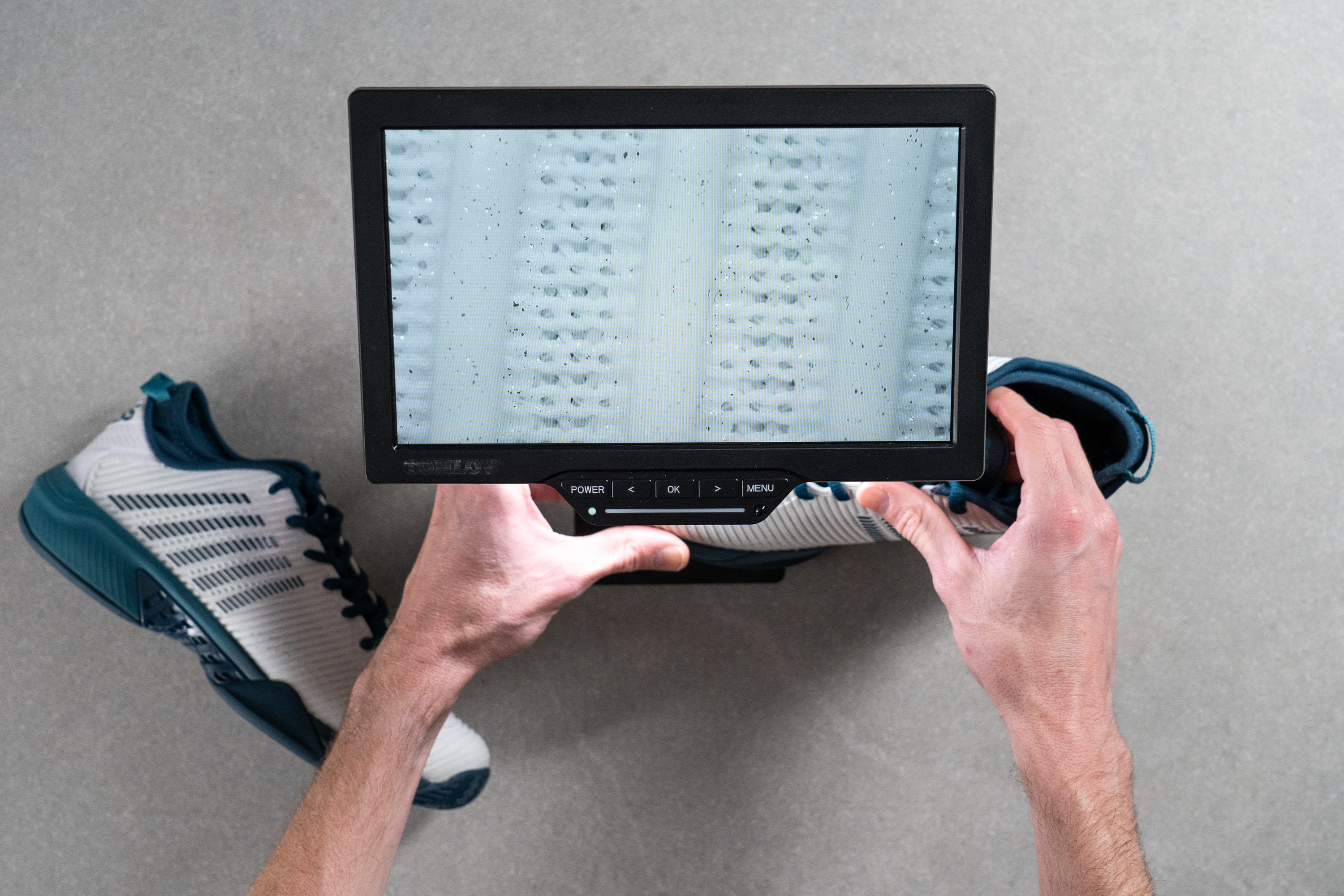
It appears as though there is breathable mesh in between the DuraWrap overlays. But a closer look reveals that it's made of pretty thick, densely woven threads that don't seem to let much air through.

| Hypercourt Supreme | 3 |
| Average | 3.2 |
Stability
Lateral stability test
As you can see from our ankle-shifting test below, the K-Swiss Hypercourt Supreme is not a very stable tennis shoe. But we wouldn't call it an ankle-rolling disaster either. It's got just enough structure for an agile, speed-oriented shoe.
Torsional rigidity
Twisting the Hypercourt Supreme in our manual test, we immediately noticed that it has a lot more give than other tennis shoes. On a 1-5 scale, where 5 is the stiffest, we assessed its torsional rigidity with a moderate score of 3. That is despite the presence of a stiff TPU shank in its midfoot.
If you have flat feet, overpronation, or other conditions that make you rely heavily on support, we recommend looking into shoes like the Adidas Barricade 13 or the ASICS Gel Resolution 9 instead.
| Hypercourt Supreme | 3 |
| Average | 4.4 |
Heel counter stiffness
A soft, bootie-like collar design is one of the shoe's main highlights. Unlike the more traditional structured heel counter that's used in the Hypercourt Express 2, the Supreme went for this pliable sock-like setup that molds around the ankle.

We can see how quick-footed players would prefer this setup to the traditional one. But we also must warn those who are used to a firmer heel hold.
Pushing and squeezing the shoe's heel counter in our hands, we rated its stiffness as low as 2 out of 5. That is significantly more flexible than average.
| Hypercourt Supreme | 2 |
| Average | 4.1 |
Midsole width - forefoot
One of the reasons why the K-Swiss Hypercourt Supreme feels more stable than it first appears is its wider-than-average platform. Measuring the widest part of its forefoot, our caliper returned 117.4 mm which is considerably larger than average.
On the playtest, we couldn't get enough of the shoe's substantial outrigger. Made of outsole rubber, not only did it extend the width of the forefoot, but it also added stopping power on hard lateral landings.
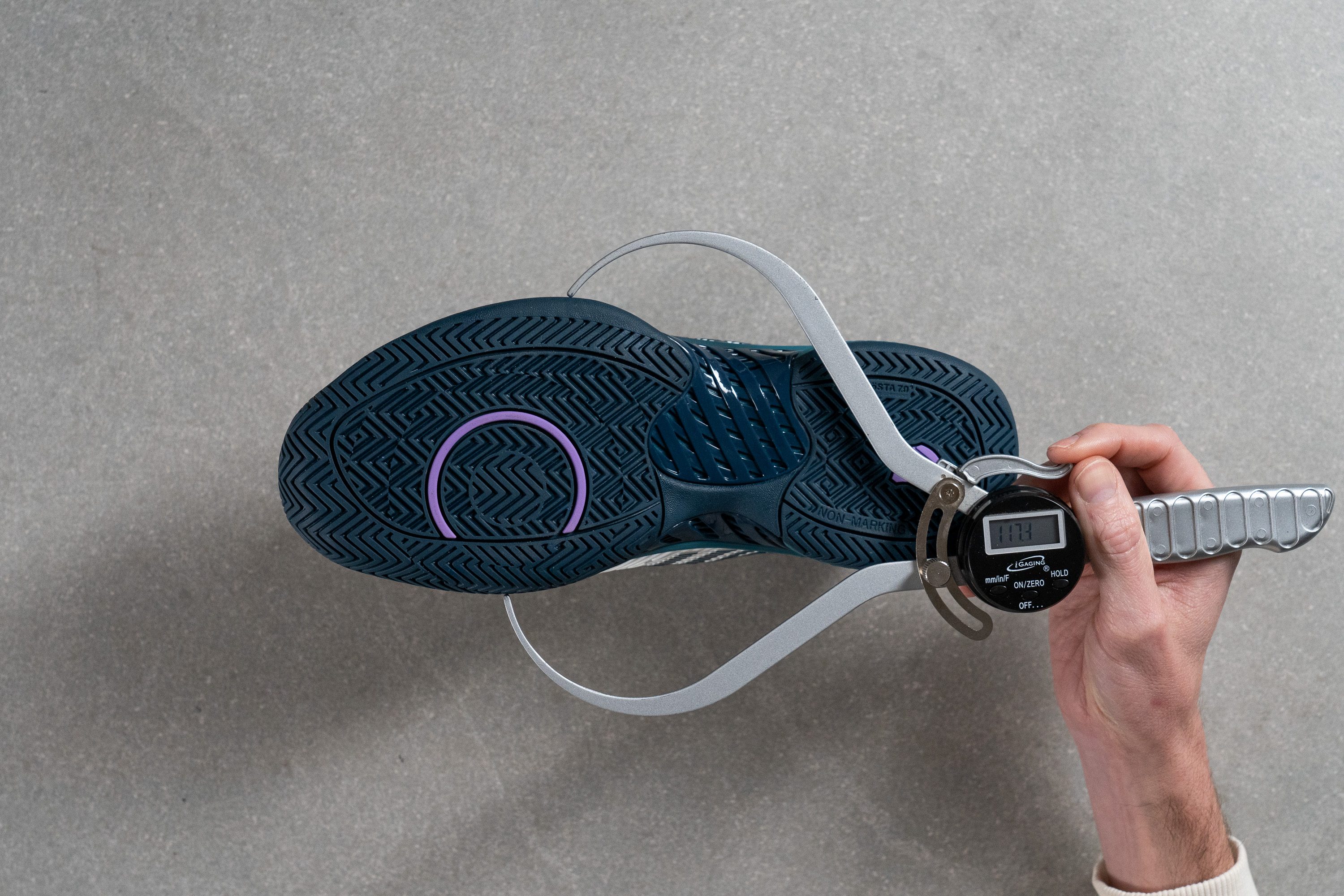
| Hypercourt Supreme | 117.4 mm |
| Average | 111.9 mm |
Midsole width - heel
Measuring the widest part of the shoe's heel, we also got an above-average reading of 91.7 mm. Mix this wide platform with the shoe's firm and grounded midsole, and you get a very stable area for landings and launches.
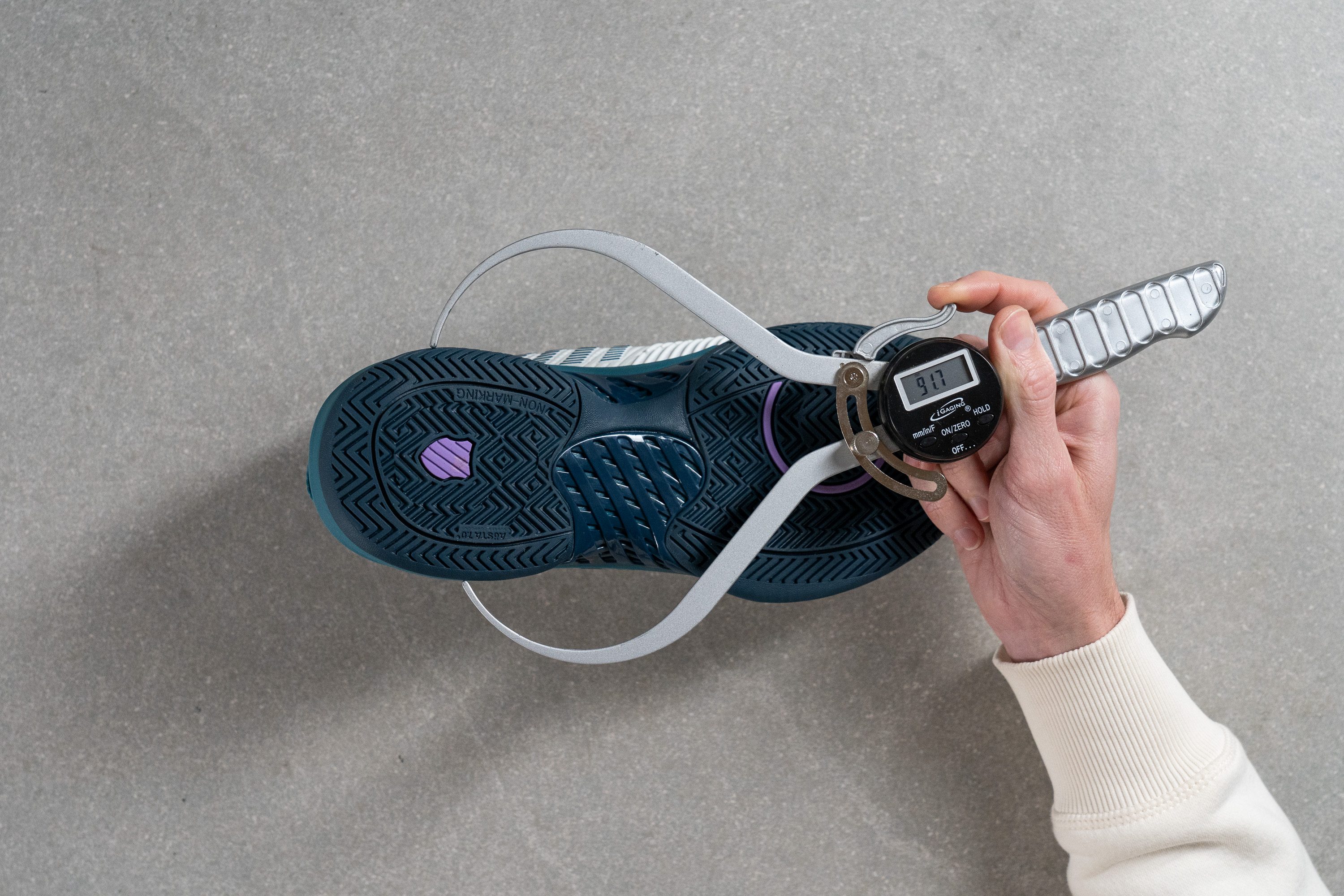
| Hypercourt Supreme | 91.7 mm |
| Average | 89.6 mm |
Durability
Toebox durability
A shoe like the K-Swiss Hypercourt Supreme is ideal for an aggressive playing style with lots of toe dragging and sliding. We have been stunned by the durability of K-Swiss tennis shoes before (hello, Hypercourt Express 2!) and it looks like the Supreme is right on par with it.
Using a Dremel with a sandpaper tip, we drilled the shoe's toebox at a consistent speed (5K RPM) and pressure (3.2N) for 12 seconds.
And once again, we were amazed at the abrasion resistance demonstrated by the brand's DuraWrap overlays. Its stripes may look subtle but they will put up a real fight to protect the upper's integrity.
Looking at the ridiculous amount of damage that the Dremel left on the Supreme, we confidently rated its toebox durability with the highest score - 5 out of 5.

The inner side of the shoe's toebox features an even denser and toothier DuraWrap for protection. It is further enhanced by the raised outsole rubber which the brand touted as DragGuard.
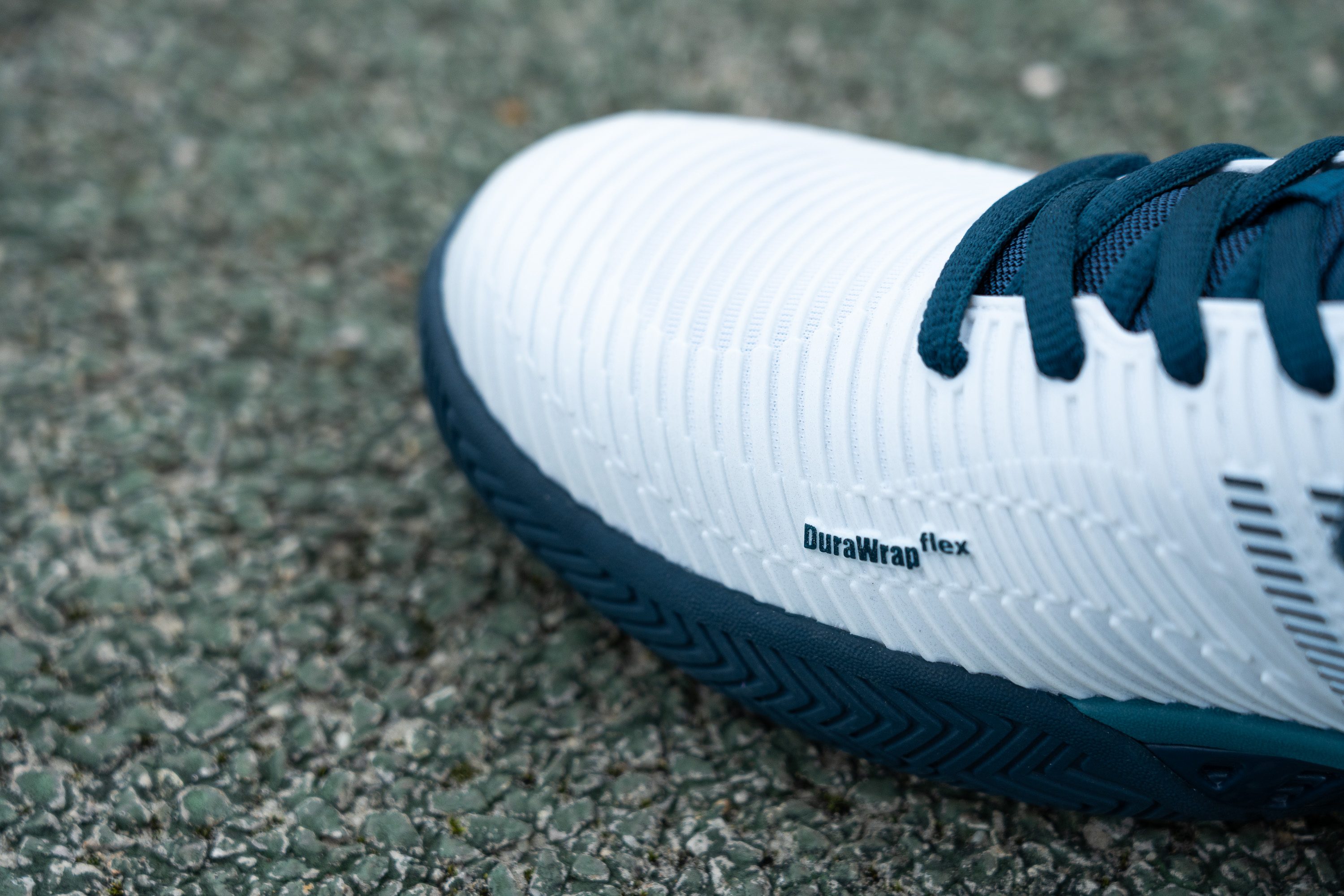
In addition, these sturdy overlays also cover the midfoot portion of the shoe.
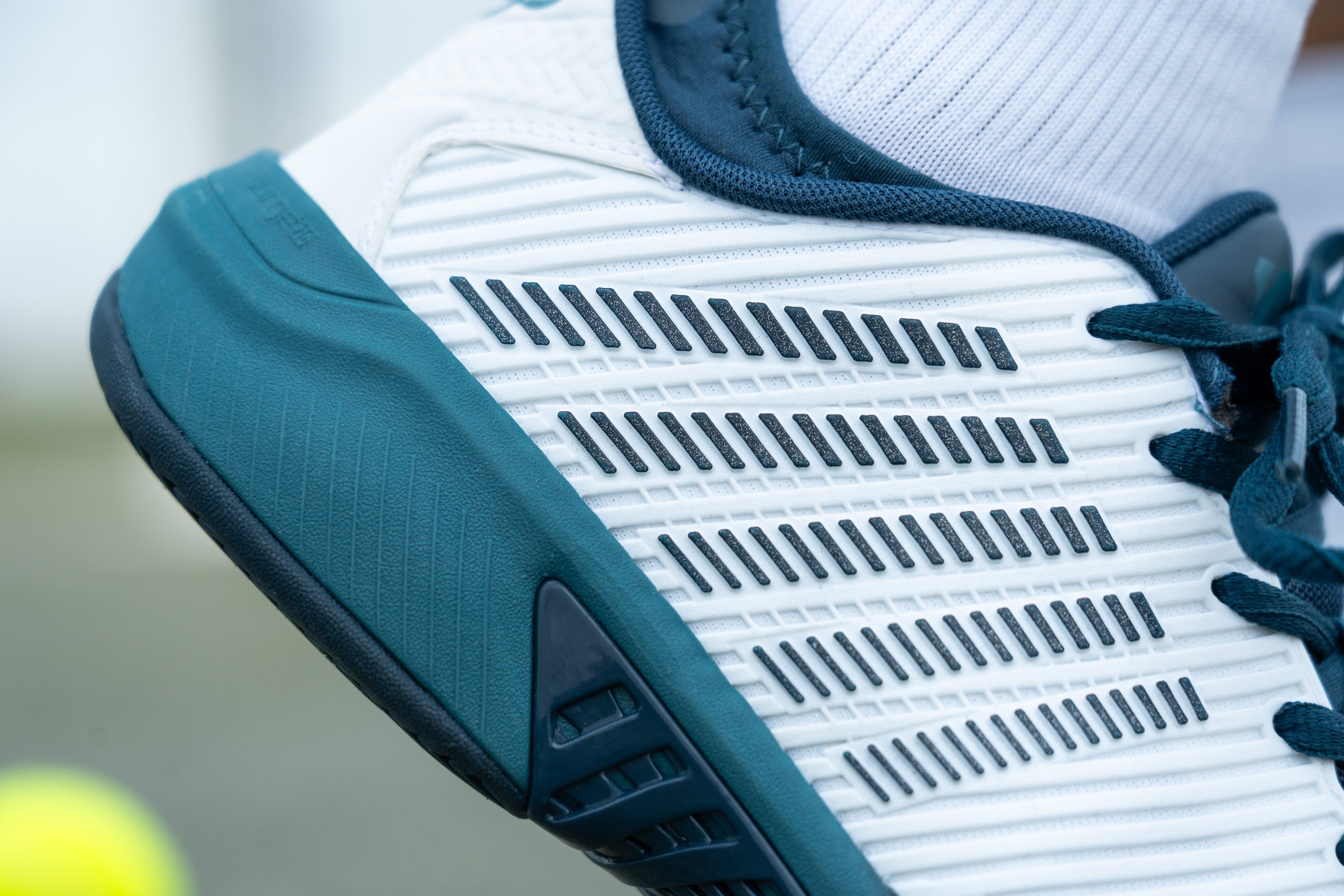
| Hypercourt Supreme | 5 |
| Average | 3.7 |
Heel padding durability
We couldn't help but notice that the Supreme uses a denser and silkier synthetic textile for the interior lining. And this material proved to be ready for non-stop friction.
In most tennis shoes, this delicate part of the upper gets torn immediately the moment we touch it with our Dremel. But not in this K-Swiss shoe.
Having drilled it for 4 seconds at a 5K RPM speed, we saw nothing more than cosmetic scuffing. This earned the shoe's heel padding durability a very high score of 4 out of 5!
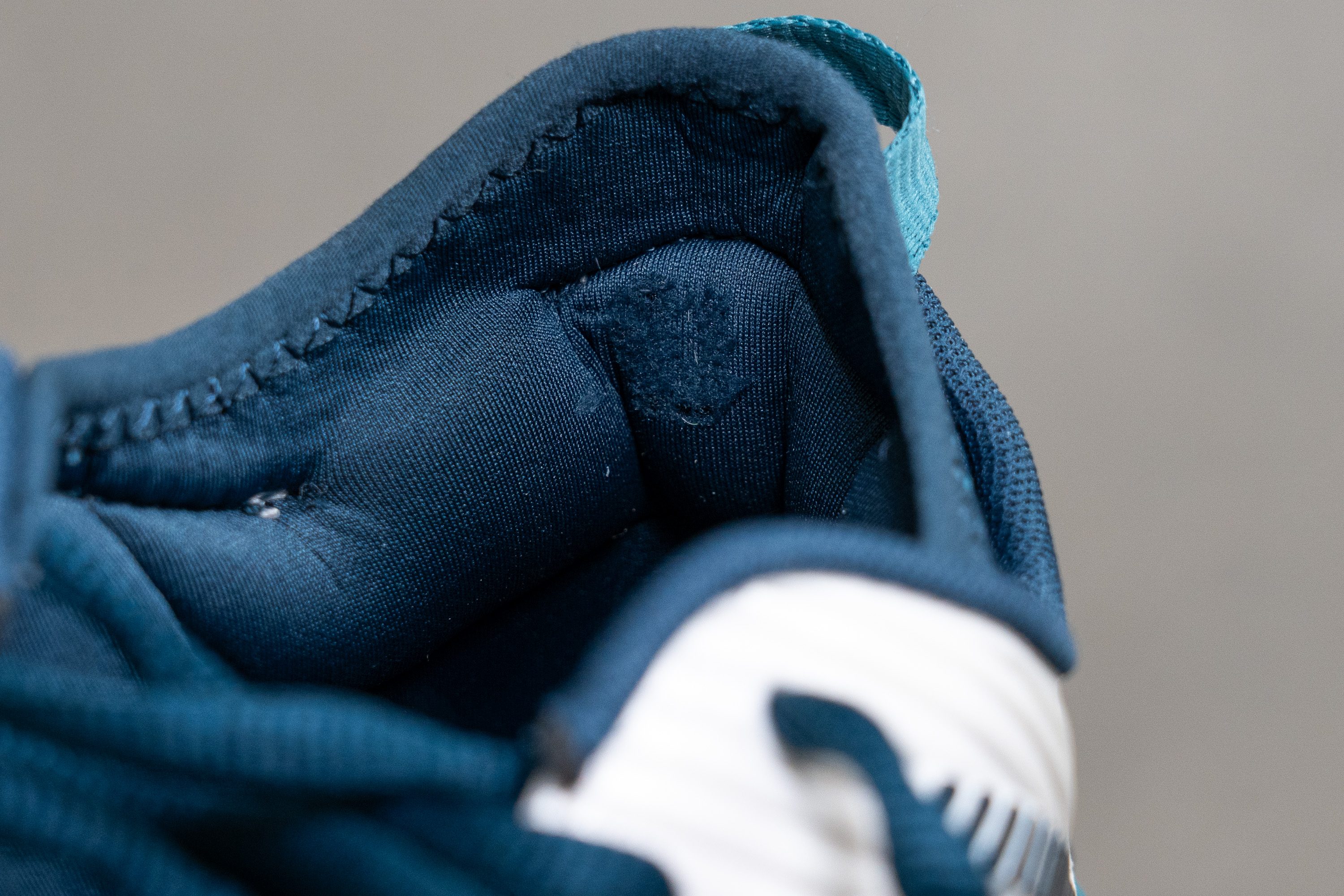
| Hypercourt Supreme | 4 |
| Average | 3.3 |
Outsole hardness
Provided that there is no outsole guarantee for the Hypercourt Supreme, our durability tests had to get even more demanding.
To begin with, we checked the shoe's rubber hardness as it quite often correlates with longevity. Seeing 84.0 HC on the durometer, we felt reassured - it is within the normal range of tennis shoes. But not on the harder end of the spectrum.
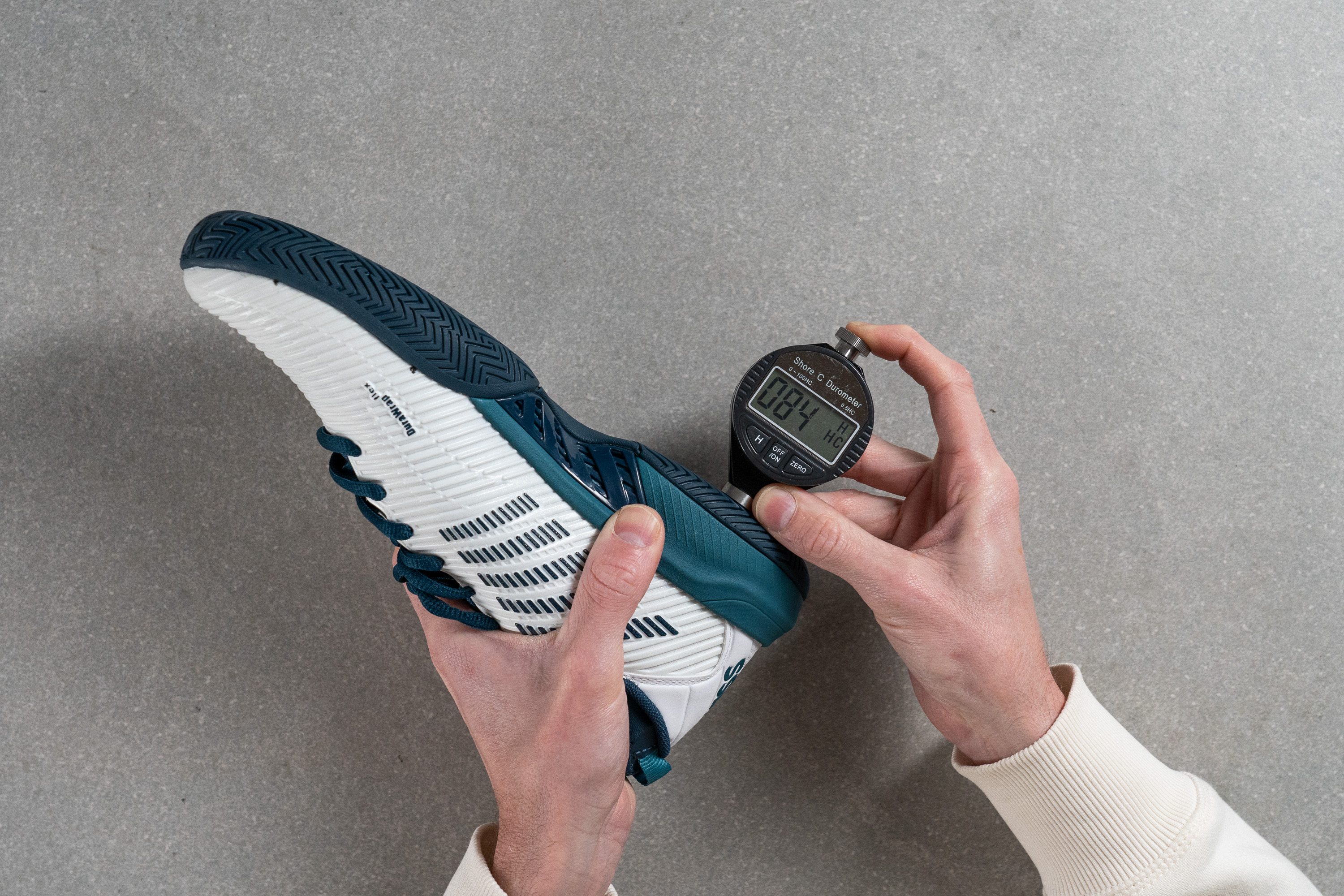
| Hypercourt Supreme | 84.0 HC |
| Average | 86.0 HC |
Outsole durability
In the next challenge, we mimicked hours of on-court play with a rather simple Dremel test. This time around, the tool was set to an unforgiving 10K RPM speed and the drilling lasted for 22 seconds.
We were quite happy to see that the tool left less than a millimeter of damage on the rubber but it wasn't better than average either (0.8 mm). This doesn't mean that you're going to blow through the outsole within a few weeks but it might wear down faster than the AHAR PLUS rubber on ASICS tennis shoes.
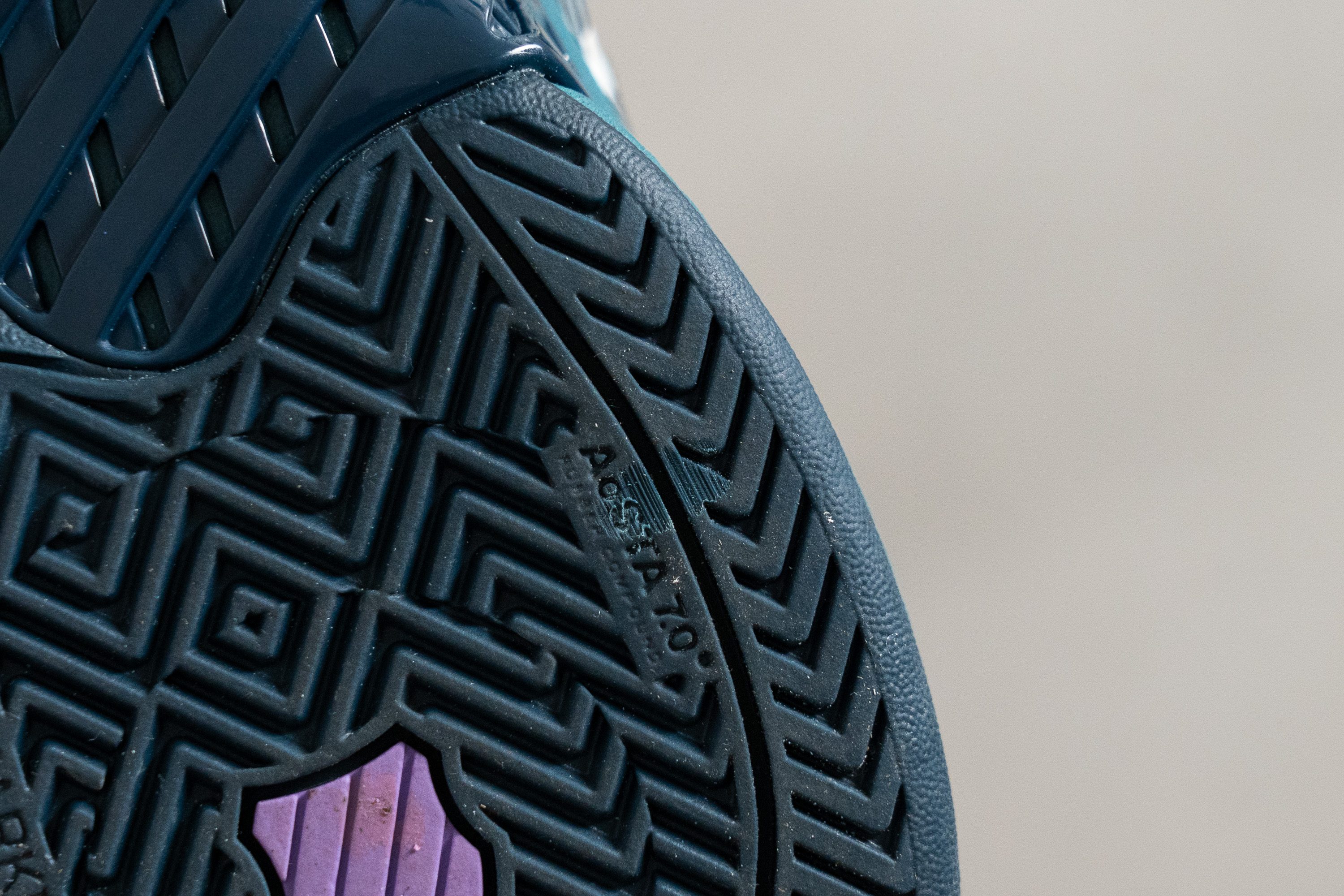
| Hypercourt Supreme | 0.8 mm |
| Average | 0.8 mm |
Outsole thickness
Another piece of good news is that the K-Swiss Hypercourt Supreme has a fairly substantial outsole. According to our caliper, it is 4.2 mm thick, a desirable number for tennis shoes.
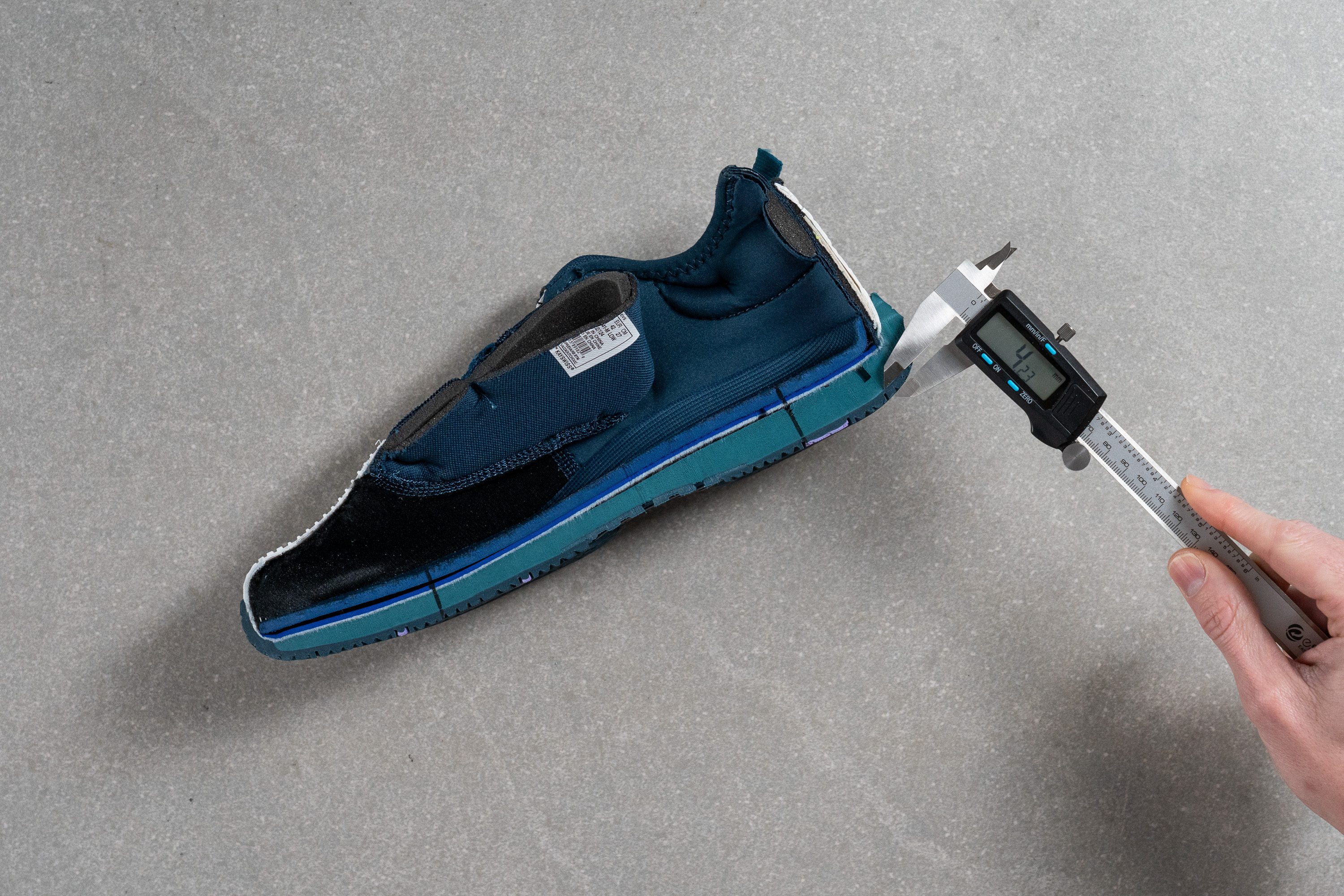
| Hypercourt Supreme | 4.2 mm |
| Average | 4.2 mm |
Misc
Insole thickness
The Hypercourt Supreme also comes with an adequately padded insole which our caliper measured at 4.7 mm. This thickness is standard for tennis shoes.
It is unlike the one we saw in the Hypercourt Express 2 which measured a whopping 8.5 mm.
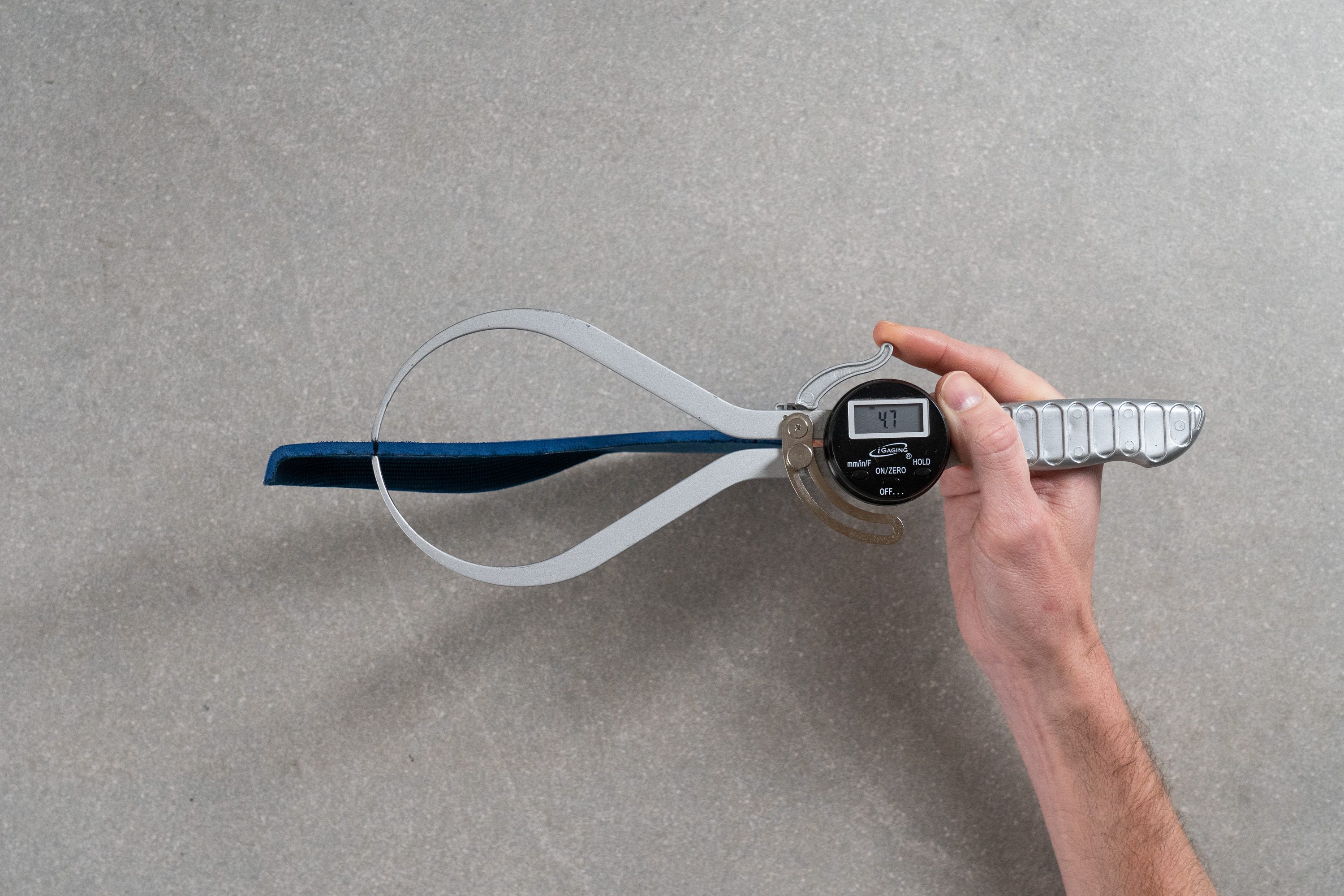
| Hypercourt Supreme | 4.7 mm |
| Average | 5.1 mm |
Removable insole
If you still want a better level of arch support in the Hypercourt Supreme, you can easily swap the shoe's stock insole for an aftermarket one.
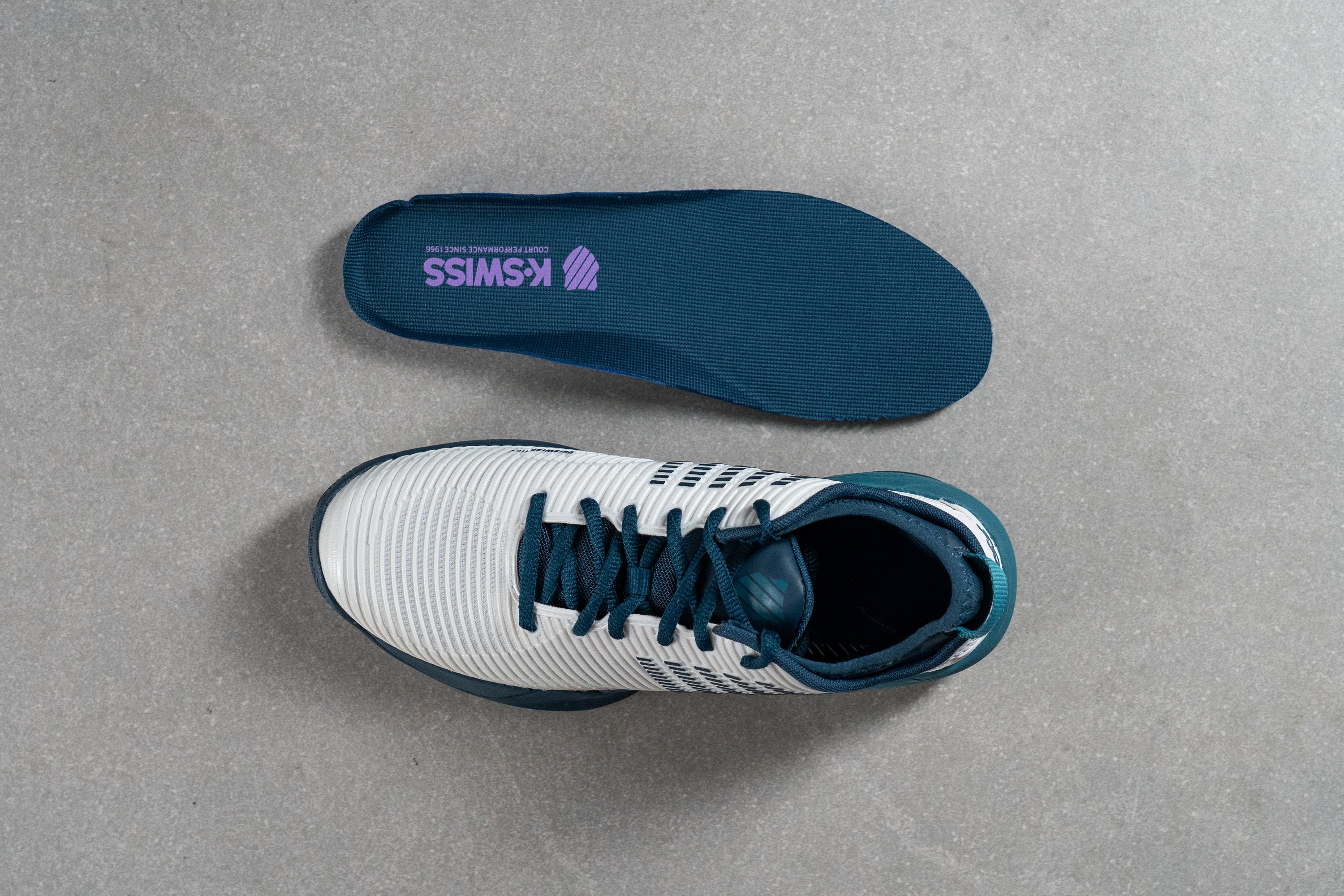
| Hypercourt Supreme | Yes |
Tongue padding
Even though it is a very light and speedy shoe, the Hypercourt Supreme doesn't skimp on the tongue padding. We measured its thickness at 10.4 mm which is more generously cushioned than average.
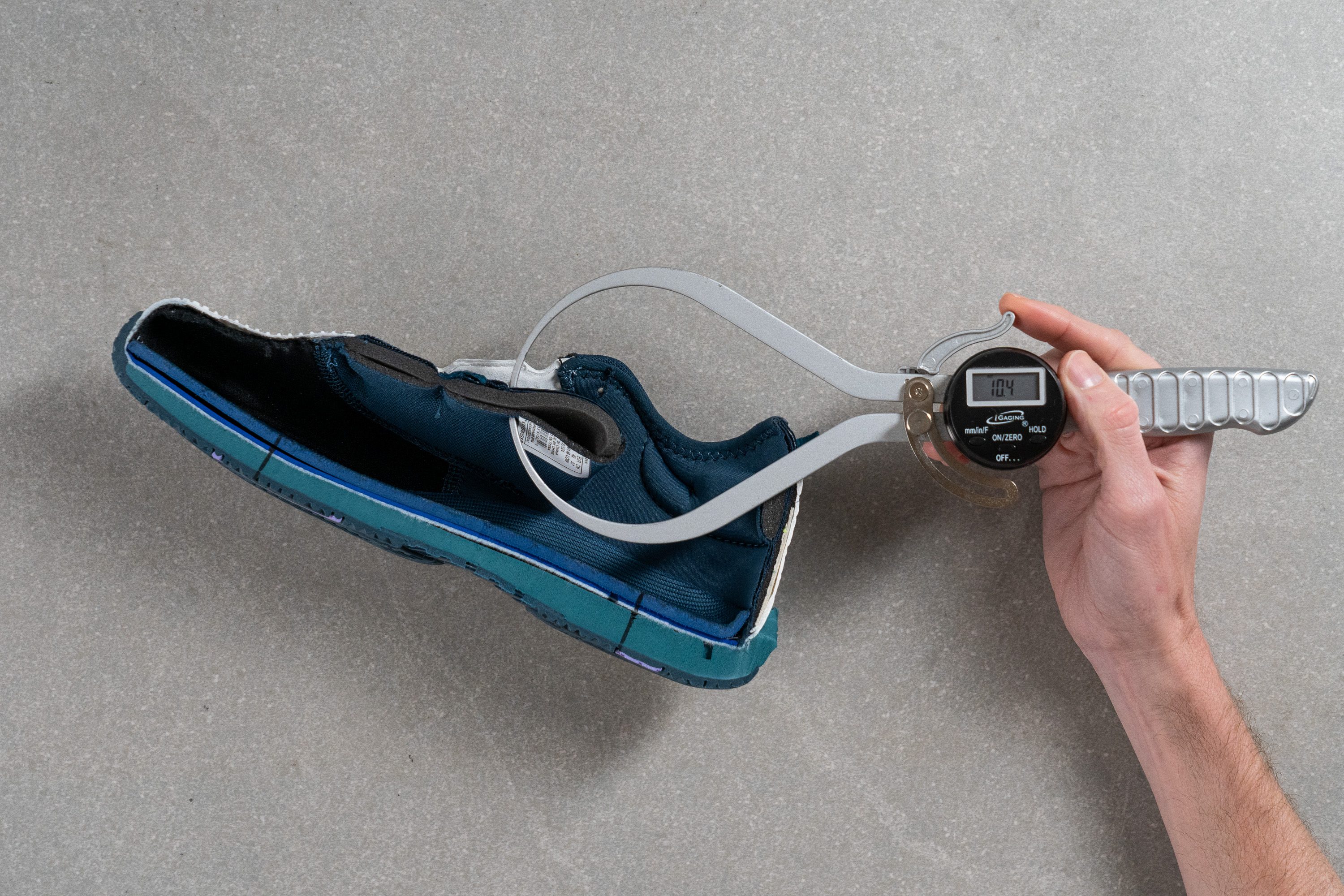
There is also a small pillow of foam wrapping around the shoe's ankle. Very subtle but just enough to hold the rearfoot.
| Hypercourt Supreme | 10.4 mm |
| Average | 8.1 mm |
Tongue: gusset type
Another key difference between the Hypercourt Express 2 and the Supreme is that the latter comes with a fully attached (or gusseted) tongue. It may not seem like a big deal but it changes the shoe's foot containment pretty dramatically.
We felt very securely locked inside the shoe with no awkward sliding of the tongue.

| Hypercourt Supreme | Both sides (full) |
Heel tab
The Hypercourt Supreme can be tricky to put on with its pliable collar and gusseted tongue. So it was thoughtful of K-Swiss to attach a handy finger loop at the back of the shoe.

| Hypercourt Supreme | Finger loop |

